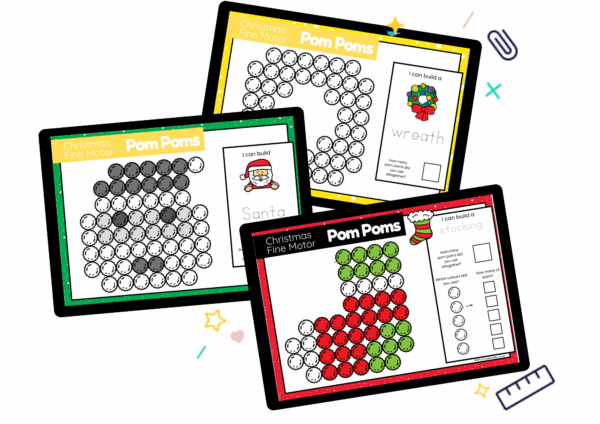Pom Pom Fine Motor Activities for Early Years Learners
Fine Motor Resources
Looking for hands-on, engaging ways to build fine motor strength in young learners? Pom Pom Fine Motor Activities are a teacher favourite—for good reason! Whether you’re supporting pencil grip, hand-eye coordination, or number skills, pom poms offer a colourful, tactile way to help children build essential early learning skills through play.
This page is your one-stop hub for all our Pom Pom Fine Motor Activities—from printables to sorting mats, counting games, and more.
Why Pom Poms?
Pom poms are an incredibly versatile classroom tool. They’re soft, safe, and easy to grip with tongs, tweezers or fingers, making them perfect for:
- Developing hand strength and finger dexterity
- Practising bilateral coordination (using both hands)
- Encouraging one-to-one correspondence
- Supporting visual discrimination and patterning
- Making maths learning multisensory
Learn more about fine motor development from Kid Sense Child Development
What Are Fine Motor Skills—and Why Do They Matter?
Fine motor skills involve the small muscles in the hands and fingers that allow children to grasp, pinch, hold, and manipulate objects. These are essential for tasks like writing, cutting, doing up buttons, and using utensils. Pom Pom Fine Motor Activities help build these muscles in fun, low-pressure ways.
Early years students often struggle with:
- Pencil control and grip strength
- Fatigue during writing tasks
- Inaccurate hand-eye coordination
- Frustration with tasks that require precision
Regular pom pom activities are a playful way to address these difficulties.
What to Look For in Student Development
As students engage with tweezers and pompoms, look for the following positive signs of progress:
- A functional pincer grip (thumb and finger working together)
- Smooth, controlled hand movements
- Confidence in picking up and placing small items
- Recognition and verbalisation of numbers 0–30
- Sustained attention during the task
Common Difficulties Students May Experience
Some students may:
- Hold tweezers with a whole-hand (palmar) grip
- Use their shoulder or wrist instead of isolating finger movements
- Avoid fine motor tasks due to frustration
- Struggle to match colours or form number shapes
- Show fatigue or lose interest quickly
These challenges are typical in the early years. With repeated, low-pressure exposure, most students show steady improvement over time.
How to Use PomPom Activities in the Classroom
PomPom fine motor activities fit seamlessly into daily routines, literacy centres, and small group rotations. Whether you’re teaching Foundation, working in a preschool setting, or delivering targeted intervention, these resources are flexible, hands-on, and easy to differentiate.
Use pompoms to isolate and build CVC words, segment sounds, and complete initial or final sound mats—ideal for supporting early phonics instruction and decoding.
Curriculum Link: AC9EFLY10 – Blend and segment sounds in spoken words for reading and spelling.
These activities are more than just fun—they’re intentional. Every printable is designed to build fine motor precision while supporting essential early literacy and numeracy skills.
Set Up Fine Motor Stations
Create dedicated fine motor stations where students can practise a targeted skill such as counting, letter matching, or shape recognition. Use the printables on clipboards, trays or in clear sleeves and pair them with:
- Jumbo or regular tweezers
- Tongs or scoops
- Pom poms in a range of sizes and colours
Rotate activities weekly to keep engagement high and build different skills over time.
Browse More Fine Motor Activities
Use Play Trays for Open-Ended Exploration
Incorporate pom pom activities into play trays or tuff trays with:
- A themed printable mat (e.g. shapes, numbers, letters)
- Pom poms for filling, sorting, or matching
- Additional sensory materials such as rice, sand, or felt shapes
Play trays encourage exploration, collaboration, and child-led learning while still targeting fine motor goals.
Integrate into Morning Tubs or Warm-Ups
Set up morning tubs or table tasks as students arrive with pom pom fine motor activities that are easy to complete independently. This builds routine while giving students a purposeful task to focus on.
Use for Targeted Support or OT Goals
These activities are ideal for supporting individual students who need extra help developing fine motor control or letter/number recognition. They can be easily used in small group work, with an aide, or even sent home for family engagement.
All activities in the collection are low-prep, print-and-go, and adaptable for multiple learners. Just print, add your pom poms and tools, and you’re ready to go.
Explore the full range of activities and see how easy it is to bring fine motor development into everyday learning.
Build Skills Without the Stress
Pom Pom Fine Motor Activities are loved by educators because they combine learning with play—no worksheets required. You’ll be supporting:
- Grip strength
- Focus and attention
- Counting and number skills
- Sorting and classifying
- Creativity and persistence
Ready to Get Started?
Click below to browse our full collection of Pom Pom Fine Motor Activities for the early years classroom.
Explore tags
Pom Pom Fine Motor Activities

Fine Motor Fun - Letters & Sounds - Unicorns

Fine Motor - Pom Poms - Christmas

Fine Motor Pom Poms - Numbers 0-30
Can't find what you're looking for?
Send us a request! Use this form to request a resource. Please give details of the learning area, topic, year level, curriculum links. We’ll be happy to take a look to see if we can fit it in. Unfortunately a request does not guarantee we will be able to make it!
"*" indicates required fields
